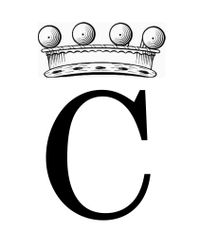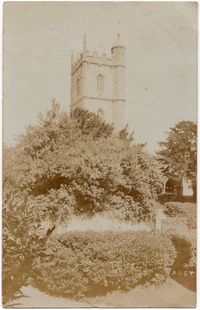The Baronial Landholdings in Medieval Times
In 1086 - or already well before in 1066 - Turstin FitzRolf held North Cadbury, known simply as Cadbury (Cadeberie), as part of the extensive fiefdom (landed properties or estates) from King William I. under the feudal tenure per baroniam - as a feudal Baron. These land holdings were presumably all royal grants for loyal service.
William the Conqueror granted most lordships in 1066. The exact date of creation of the barony cannot be determined, as the founding charter has been lost, but was first recorded in Domesday Book of 1086. The King rewarded his loyal knights with massive amounts of land throughout the length and breadth of the country and they became ennobled and created baron. For his loyalty, William gave Turstin FitzRolf in total 77 manors. Turstin's barony comprised more than 30 manors and knights' fees in Somerset and nearby counties.
In particular Turstin held also the castle of Caerleon, at the southern end of the English frontier with unconquered Wales. Turstin's caput or seat of the barony was (North) Cadbury, but it is believed that his central area of operation seems to have been around Caerleon Castle on the English border with Glamorgan, South Wales.
Caerleon Castle was a motte-and-bailey castle. From the apparent banishment of Turstin by William II, it was held from 1088 by Wynebald de Ballon, brother of Hamelin de Ballon who held Abergavenny further up the River Usk.
After battles between the Welsh and Normans in 1171 the town was destroyed and the castle burned off. At that time Caerleon was an important market and port and became a borough probably by 1171. In 1217 the castle and borough were seized by William Marshal, 1st Earl of Pembroke and Caerleon Castle was rebuilt in stone.
In about 1092, after the banishment of 1st Baron Turstin FitzRolf to the death of James de Newmarch the 5th Baron of North Cadbury in 1216, the Barony of North Cadbury remained an honor of 18 manors and knights' fees.
These incorporated following possessions of manors or estates in several other counties adjacent to Somerset:
Gloucestershire/Worcestershire/Herefordshire
Berkshire/Wiltshire
Buckinghamshire
Devon/Dorset
Hampshire
Somerset
North Cadbury
the Manor and Baronial seat (caput) of the Barony (fiefdom).
It contained following hamlets:
1. Galhampton on the north,
2. Brookhampton, a continuation of North Cadbury,
3. Catsash, on the west and
4. Woolston, on the east.
South Cadbury
with the famous Cadbury Castle, from which the Barony takes its name. The location of the hill fort of Cadbury Castle, also known as the legendary King Arthur's Camelot.
Compton Pauncefote
Horsington
(anciently Horstentone)
It contained following hamlets:
1. Horsington-March on the east,
2. South Cheriton, commonly called Cheriton, on the north,
3. Wilkenthorp on the west and
4. Horwood, detached, on the east.
- Blackford
- Maperton
- Holton (anciently Halton)
- Clapton
- Weston Bampfylde
- Eastrip
- Wilford
- Snydercombe - since mid 1960's flooded by Clatworthy Reservoir
Gloucestershire
Dyrham
Aust
Manor of Hasfield
Manor of Eastington
The Manors of Eastington and Fretherne, the two Knight's fees. Wynebald de Ballon with his son Roger donated the tithes to Bermondsey Priory.
- Gotherington (Godrinton)
Buckinghamshire
Little Kimble
Hardwick with Weedon: Hardwick Manor
A fee of Wynebald de Ballon and Henry de Newmarch. Wynebald de Ballon donated a part of Hardwick to Bermondsey Priory.
Berkshire
- Frethornes In 1166 William de Frethorne held two knight's fees of Henry de Newmarch: Frethornes and the other in Childrey.
- Childrey
- Upton (now Oxfordshire) One moiety was granted from Wynebald de Ballon in 1092 to the Cluniac Priory of Bermondsey, then it was known as Prior's Barne. The other moiety passed in the middle of the 12th century to Henry de Newmarch who granted it to Bermondsey Priory, after his death in 1204 to his brother James.
Hampshire
Newton Valence
This list is not intended to be exhaustive, but there are further more manors.
Copyright © THE BARON de NEWMARCH COLLECTION. All Rights Reserved.


